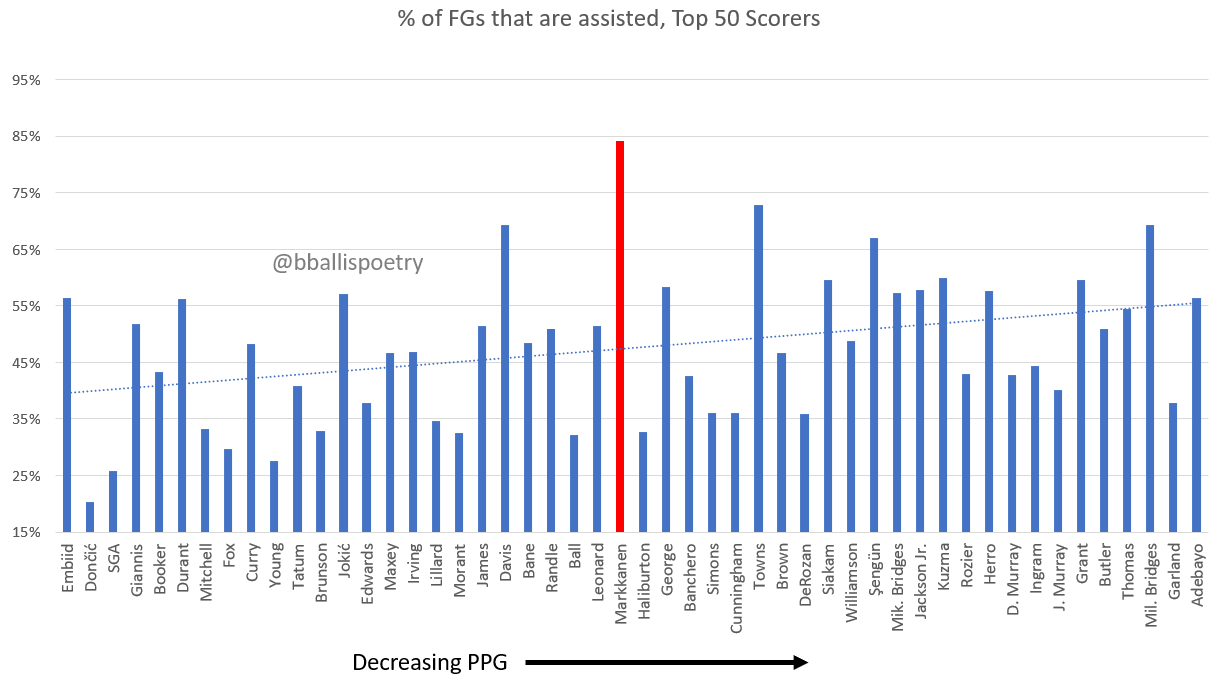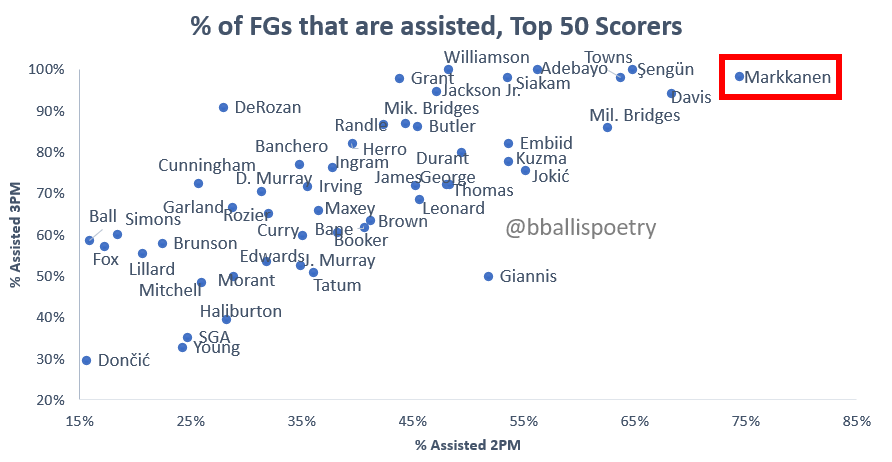The Utah Jazz’s Lauri Markkanen, the Finnisher himself, is turning in a historic scoring campaign this season.
Last year, Markkanen took a steel wrecking ball to preconceived notions of his ceiling, blowing the doors off his career averages to become an All-Star and win the Most Improved Player award. This year, he’s posted remarkably similar numbers, averaging 24 points, nine rebounds, and two assists while shooting 49% from the field and 40% from distance on eight attempts. But the raw numbers here hide multitudes.
Per Synergy, the seven-foot sharpshooter is one of the most versatile scorers in the league — he’s in at least the 62nd percentile in points per possession (*takes deep breath*) on spot-ups, off screens, in transition, off cuts, as a roll man, on offensive rebounds, in the post, and in isolation. Imagine a giant crossbow shooting elite percentages from nearly everywhere on the floor but which can also dunk defenders into an early grave, and you’ve got the right idea.
The three-point shot is the key to making it all happen. Markkanen isn’t just a stationary shooter. He can catch the ball on the move and get it up in a hurry, and closing defenders bother him as much as an ant annoys a giraffe.
Just like last season, defenders can’t fully commit to the three-pointer because Markkanen is always a threat to fake toward the three-point line before cutting back for the lob.
(Hilariously, the Jazz occasionally run that same play for unassuming forward Simone Fontecchio, too. Markkanen isn’t the only Jazz shooter with some bounce!)
At face value, relatively little has changed with Markkanen’s role or output this season. But something interesting is happening below the still surface waters. After last year’s breakout season, I expected him to start using the ball more. 75% of his buckets were assisted, a very, very high mark for an elite scorer. The natural next step seemed to be more self-creation as he explored the limits of his game.
I was wrong. This year, that number has increased to 84%. That just… doesn’t happen with a team’s leading bucket-getter.
How Markkanen compares to other Top-50 NBA Scorers
As of this writing, Markkanen is the 25th-highest scorer in the league, per Basketball-Reference. 84% is by far the highest percentage of assisted buckets of any players around him; no one else even comes close. Look at this!

Generally speaking, the highest-scoring players are the league’s alphas, who tend to self-create more of their shots. That’s what makes them an alpha: the ability to efficiently generate offense for themselves (and usually, although not always, others). As we go down the row toward more secondary options (typically forwards or bigs), assisted percentage slightly increases on average. But nobody approaches Markkanen’s reliance upon teammates.
(Side note: check out Doncic, who rides solo for over 80% of his buckets. Even for a ball-dominant point guard, that number stands out. Crazy.)
The difference between Markkanen and his high-scoring peers is even more apparent when we break it down by assisted twos and assisted threes:

In fact, Markkanen’s dependence upon assists is unique in NBA history at least as far back as 1997 (when Basketball-Reference’s shooting data stops).
Markkanen's lack of self-creation is unprecedented in NBA history
There has never been a player who averaged more than 20 points per game and created a lower percentage of his field goals. Only four players have ever scored 20 with an assisted percentage of 80% or higher: Markkanen now, Kristaps Porzingis in 2020, Klay Thompson five times, and Karl Malone twice.

As someone who has often compared Lauri Markkanen to Klay Thompson, I’m happy to see statistical proof that backs up the eye test. *Stretches, pats back.*
Two offsetting factors are worth noting. First, most of his unassisted twos are putbacks and layups in transition. While that counts by technicality, it’s not what people really mean when they discuss self-creation.
Second, Markkanen shoots more than five free throws per game, a decent number (although not an elite one). But most of his free throws still come off cuts and rolls to the basket (which would have been assisted if he made the shot), not off him attacking off the bounce. In aggregate, I’d argue that these paltry self-creation numbers might overstate how many biscuits Markkanen is baking for himself.
It’s hard to know what to make of this. On the one hand, shots coming off passes are generally more likely to go in. The Jazz understand this — they’re tied for fourth in the league in potential assists per game. Much of the team’s offense involves getting Markkanen the Wilson in his comfort zones (which increasingly comprise the entirety of the court), and his activity off the ball has the gravitational pull of a black hole, opening things up for teammates. Ballhandling and passing aren’t Markkanen’s strengths. He’s a smooth athlete for his Brobdingnagian size, and he’s quicker or stronger than nearly everyone who guards him, but he rarely creates advantages for himself or others with the rock. It makes sense to optimize him to the fullest as an off-ball threat.
On the other hand, it does leave Markkanen vulnerable to being frozen out for periods as the Jazz’s unusual hodgepodge of guards and wings take their turn trying to get some. Jazz coach Will Hardy deserves all the credit in the world for getting his players to tap into their playmaking side — this year, veterans like Collin Sexton, Jordan Clarkson, Kelly Olynyk, Markkanen himself, and even Talen Horton-Tucker are all averaging career-highs in assists per possession. But Olynyk might be the only player on the team who is an above-average passer for his position, and he and Dunn are by far the most willing. The data says that Markkanen is a beast in fourth quarters, but fans have grumbled during some losses when Markkanen goes for a few minutes at a time without touching the ball late in games.
The inability or unwillingness to let Markkanen create his own shot could matter this postseason. The best defenses can throw a stick into the Jazz’s bike tires and grind their scoring to a halt — Utah has been a mediocre offense against the league’s top-10 defenses all year, and that hasn’t changed even with the new lineup the Jazz unveiled in late December. It’s hard to see how someone so dependent upon teammates can be a top-tier force in the playoff crucible, when scouting reports improve, defenses are locked in, and even simple passes get harder.
But then again, if Utah makes the playoffs (far from a certainty, given the likely competition for the play-in spots), they’ll be a heavy underdog in the first round anyway. The Jazz aren’t expecting a deep playoff run this season. They are flush with other teams’ picks and, with luck, will have ample opportunities to add a more traditional alpha via draft or trade. Like Thompson, Markkanen seems best suited to being the second option, commanding defensive attention with his off-ball activity while simultaneously enjoying more breathing room next to a ballhandling star. It’s why he’s a big name coming up for this season’s trade deadline, when several teams may make a run at him, but also why he’s a perfect player for a reloading Utah team to hold onto. His reliable shooting and low-maintenance playstyle are a safety net for younger players, and at just 26 years old, Markkanen should be a strong contributor for years to come. Right now, he may be a Robin wearing Batman’s cape, but that’s not a bad thing! Letting him stretch himself as the lead Jazzman should pay dividends down the road when his role changes.
All that said, I’d love to see Markkanen initiate more. He’s not even particularly aggressive attacking closeouts, preferring to shoot over them with his high vantage point or pass it back out to reset the offense. There’s some pulpy juice to squeeze here. Even if he takes a slight hit to his sparkling efficiency numbers, I want to see more efforts at off-the-dribble creation, particularly given Utah’s lack of other elite scorers.
For now, though, it’s just plain fun to watch the Jazz and see an All-Star-caliber player doing something historically unprecedented. Nobody in league history has scored this much while commanding the ball so little, making Markkanen’s unconventional success a delight to watch.

